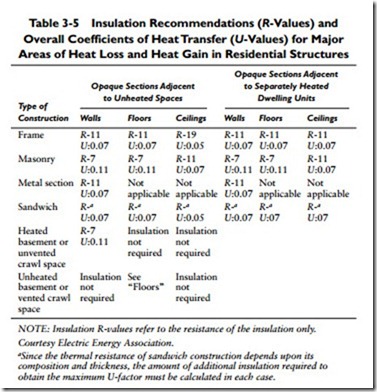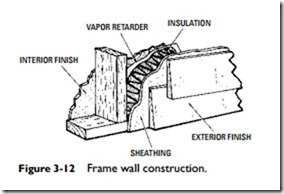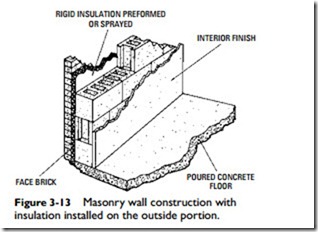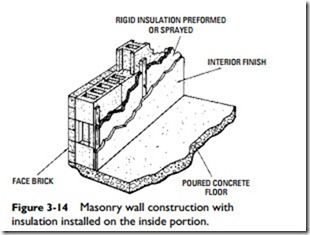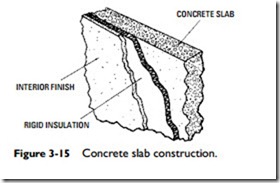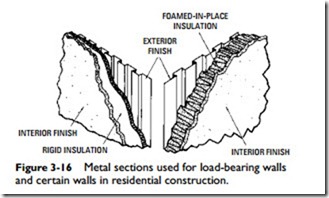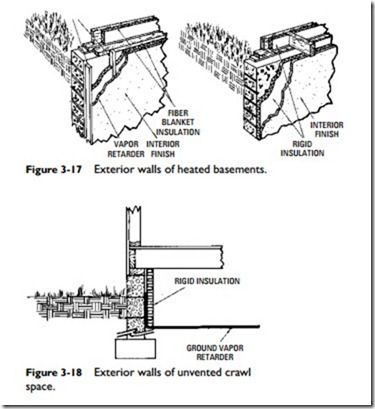Recommended Insulation Practices
The recommendations found in the following paragraphs will contain references to U-values and R-values. As was already stated in this chapter, the U-value is the overall coefficient of heat transfer and is expressed in Btu per hour per square foot of surface per degree Fahrenheit difference between air on the inside and air on the outside of a structural section. The R-value is the term used to express thermal resistance of the insulation. The U-value is the reciprocal of the sum of the thermal resistance values (R-values) of each element of the structural section. Table 3-5 lists the insulation recommendations for structures both in terms of R-values and overall coefficients of heat transfer in terms of U-values.
Frame Walls
Frame walls (Figure 3-12), with either wood or metal studs, are commonly insulated with rolls and batts of mineral, glass, or wood- fiber insulation material. Sprayed-on or foamed-in-place rigid insulation is also being used more and more. Whatever the insulation decided upon, exterior opaque walls and walls between separately heated units should have a maximum U-factor of 0.007, which will require insulation rated at R-11 or greater (see Table 3-5). A thermal resistance of R-11 can be provided by 31⁄2-in fiber batts or other equally suitable materials.
Masonry
A masonry wall is a particularly poor thermal barrier. A typical masonry cavity wall (4-in face brick on the exterior, an air space,
4- in concrete block, an air space, and a layer of gypsum wall board) has a thermal resistance equal to approximately 1 in of rigid insula- tion. Exterior opaque masonry walls should have maximum U– value of 0.11, requiring insulation rated at R-7 or greater. This can be accomplished in the following ways:
1. Place a layer of preformed rigid insulation between the exterior face brick (or other finishing material) and the concrete block during construction (Figure 3-13). Another method is to leave the space empty and then fill it with a foam insulation before capping the wall.
2. If no air space exists between the exterior face brick or other exterior finish and the concrete block, it will be necessary to add a layer of suitable insulating material (rated R-7 or bet- ter) on the inside surface of the block (Figure 3-14). The insulating material can be rigid insulation attached to furring strips or preformed rigid insulation secured in place with adhesives. An interior wall finish is then applied over the insulating material.
If the wall is constructed entirely of concrete, apply preformed rigid insulation to either side by adhesive bonding and cover the layer of insulation with a wall-finish material (Figure 3-15). The insulation must be rated R-7 or better.
Metal
Exterior opaque metal walls (Figure 3-16) should have a maximum U-value of 0.07. This will require insulation having a thermal resistance rated at R-11 or better, which can be provided by a layer of rigid insulation either preformed or foamed in place.
Sandwich Construction
Sandwich or layered construction will vary in composition and thickness but will typically consist of three layers: two facings and a core. Exterior opaque walls of a sandwich construction should have a maximum U-value of 0.007. The thermal resistance (R– value) must be calculated on the basis of its composition and thickness.
Basement Walls
There is no need to insulate the exterior walls of unheated basements, because there is no need for reducing heat loss. The exterior walls of heated basements (or interior walls separating heated from unheated areas) are a different matter, because heat loss is a concern here. An insulating layer having a thermal resistance rated at R-7 or greater should be applied. Figure 3-17 illustrates two methods for insulating these walls.
Crawl Space Exterior Walls
The exterior walls of unvented crawl spaces should be insulated with a material providing a thermal resistance of at least R-7 or better. A method for doing this is illustrated in Figure 3-18. No insulation is required for the exterior walls of vented crawl spaces.
